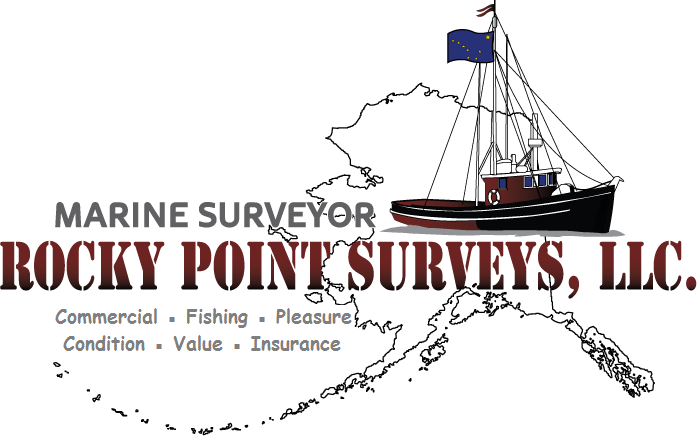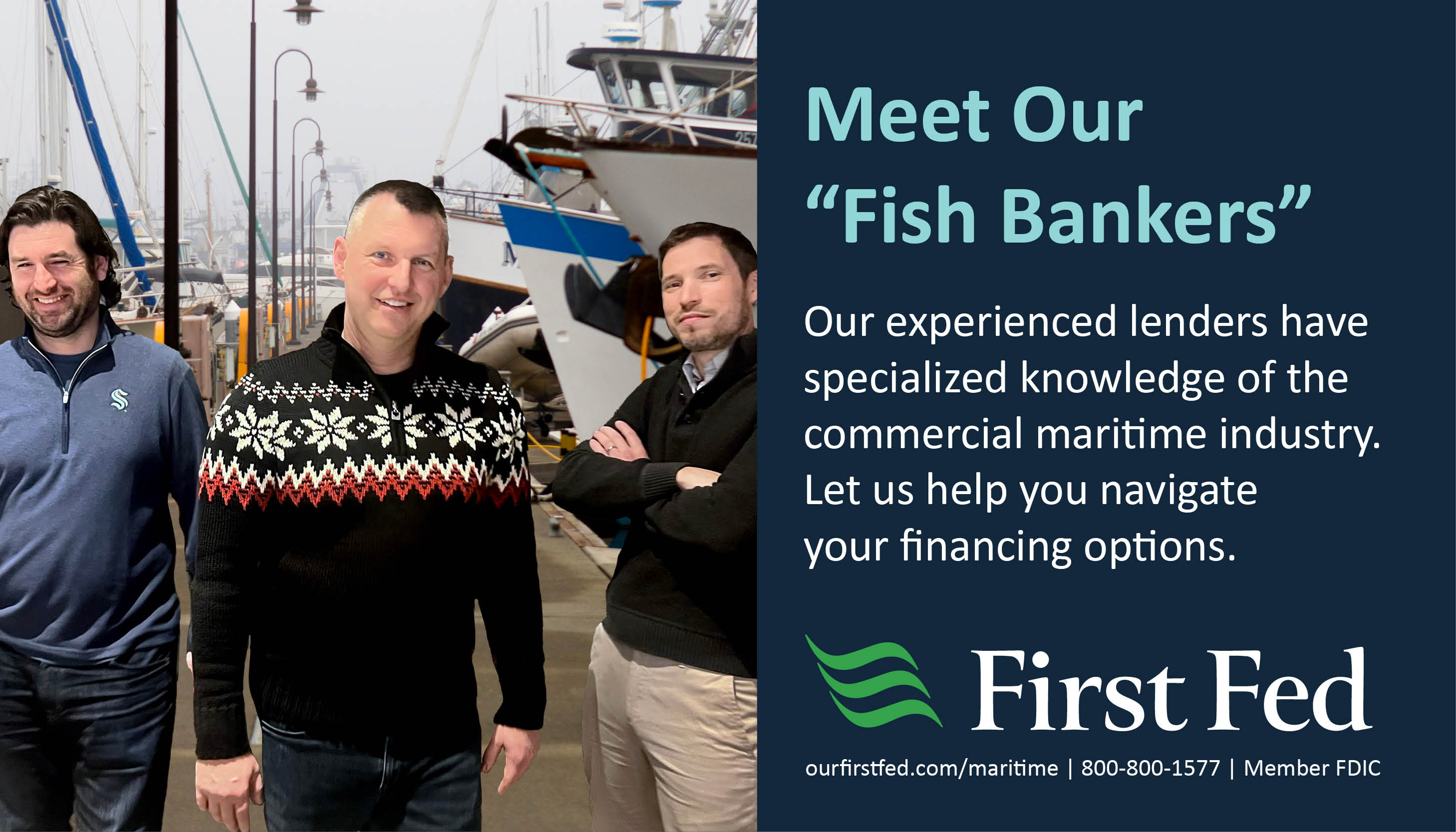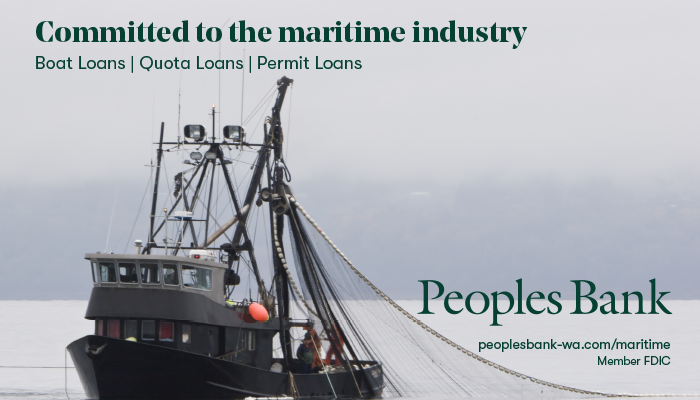Fish Factor by Laine Welch
April 2, 2021
The mask requirement for all persons aboard fishing vessels still stands and Alaska’s U.S. Senators are adding their clout to have it removed.
A Coast Guard Marine Safety Information Bulletin issued on March 22 states its authority to restrict vessel access to ports and operations if they fail to follow the rules as defined by the Center for Disease Control (CDC).
“Vessels that have not implemented the mask requirement may be issued a Captain of the Port order directing the vessel’s movement and operations; repeated failure to impose the mask mandate could result in civil and/or criminal enforcement action,” the Bulletin says.
The CDC mask requirement has been interpreted by the Coast Guard to apply to “all forms of commercial maritime vessels,” including cargo ships, fishing vessels, research vessels and self-propelled barges.” It requires “all travelers” to wear a mask, including those who have been vaccinated, according to National Fisherman which added, “Why commercial fishing vessels have been included in a requirement written for airplanes, trains, subways, buses, taxis, ride-shares, trolleys, and cable cars has yet to be explained by the Coast Guard.”
“Senator Murkowski and I have been pressing this relentlessly on a call with the Coast Guard commandant, a call with the White House guy who's supposedly in charge of all the CDC issues, we had a meeting with the head of the CDC, we are trying to explain to them how, no offense, but just how stupid this is and how uninformed it is,” Senator Dan Sullivan said last week at a ComFish forum. “And it could be a safety issue, not with regard to COVID, but with having to wear masks when you're out on the deck of a ship in 30 foot waves trying to bring in gear or pots. So, we're going to continue to work on that one.”
“The CDC has planted their heels on this one as I understand it,” echoed Doug Vincent-Lang, commissioner of the Alaska Department of Fish and Game. “Certainly, from a realistic standpoint, it makes no sense. So we're on the front side of that conversation.”
Vincent-Lang added that he is speaking with members of other coastal states and hopes to garner support to overturn the mask requirement.
“I think to the extent that we can form some kind of a unified position on this issue across more states, we stand a better chance of changing it. Because this is a CDC guidance which can be changed depending upon how they get policy direction from the White House. And if they hear from other coastal states in addition to Alaska, they'll probably be more inclined to do it,” he said.
Feedback on the masking rule can be given at [email protected].
Trade talk – Alaska’s senators also spoke candidly about ongoing trade policies with Russia that hurt the U.S. seafood industry, and expressed hope for change under the new administration.
Russia stopped purchasing any foods from the U.S. and other nations that imposed sanctions on Russian individuals and businesses after its illegal land-grab of Crimea from Ukraine in 2014. Meanwhile, U.S. purchases of seafood from Russia have increased every year.
Russian seafood imports to the U.S. in 2020, for example, topped 97.5 million pounds valued at nearly $1 billion, compared to 80.2 million pounds in 2019 valued at nearly $698 million.
“I think it was the one area where the Trump administration was kind of weak. I thought we could have done more,” said Senator Sullivan, calling the lack of action “a disappointment.”
Sullivan said he raised the issue “front and center” in a recent meeting with new U.S. Trade Representative Katherine Tai and called her “very impressive.”
“I said, look, it's just ridiculous. Six years! I mean, that embargo started at the end of the Obama administration and the whole Trump administration. Meanwhile, most of their fish comes in almost duty free, and they're taking market share from our fishermen in America. She's going to look hard at this.”
Senator Murkowski added that she intends to raise the trade imbalance with new Secretary of State Antony Blinken and encourage him to include it in diplomatic discussions with Russia.
“The fact that this has been in place for as long as it has, the fact that it has caused harm to our fisheries is something that the education needs to continue at different levels. You've got U.S. trade, but you've also got the State Department with regards to the relationship that you have with Russia. This is one thing that I think we all agree we have got to have addressed. It has been going on for far, far too long and quite honestly, it's untenable.”
Both Senators also said they spoke with the Secretary of State and the National Security Advisor when they recently passed through Anchorage on their way to China and “pressed them hard to work on tariffs that the Chinese have put on our exports.”
Murkowski and Sullivan also addressed many more topics at ComFish, including actions they are taking to mitigate climate change. View the full presentation at www.comfishak.com/
Hatchery hauls - Last year nearly 31 million salmon that got their start in Alaska hatcheries were caught in commercial fisheries, or 27% of the statewide harvest. The dockside value of $69 million comprised 23% of the state’s total salmon value.
That’s according to the annual salmon enhancement report newly released by the Alaska Dept. of Fish and Game.
There are 30 hatcheries producing salmon in Alaska, of which 26 are operated by private, nonprofits funded primarily from sales of a portion of the returns, called cost recovery. There also are two state-run sport fish hatcheries, one research hatchery operated by NOAA Fisheries, and one hatchery operated by the Metlakatla Indian community.
At Prince William Sound, where six hatcheries operate, about 15 million hatchery salmon were harvested in 2020. Those fish accounted for 70% of the total commercial catch that was worth nearly $27 million at the docks, or 67% of the total value for the region.
At Southeast Alaska, 14 hatcheries operate, split between northern and southern regions. Last year, fewer than 4 million hatchery salmon were caught accounting for 45% of the total harvest and 52% of the value to fishermen at $18 million.
Two hatcheries operate at Kodiak where last year nearly 5 million salmon were harvested worth about $5 million, or 11% of the total dockside value. Nearly all of the fish were pinks.
The three hatcheries at Cook Inlet produced just under 200,000 salmon valued at $585,000, or 6.9% of the region’s total to fishermen.
Alaska’s combined hatcheries released 1.7 billion juvenile salmon in 2020 and are projecting a return this year of nearly 66 million fish.
Get schooled! - A first-ever, field-based Alaskan Aquaculture Semester in Sitka is being offered this fall to a dozen students fromAlaska and across the nation.
It’s part of the University of Alaska/Southeast Fisheries Technology Program that has been preparing students for jobs throughout the industry since 2009 with classes focusing on aquaculture and salmon enhancement and fisheries management.
The aquaculture semester adds in more direct training on the water.
“Students will come here and be able to get 13 credits of instruction with courses in salmon culture and mariculture, and also in cold water survival,” said Angie Bowers, assistant professor with the Fish Tech Program. “And they're going to learn how to drive boats and fix motors and tie knots and how to be safe. They will also be able to do an internship based on whatever they're interested in. We'll tour processors, they will be able to help out at local hatcheries and shadow fishermen.”
There are three salmon hatcheries in the region where students will help with egg takes and learn about fish pathology and rearing prior to the tiny salmon heading out to sea. Bowers said students also will be introduced to shellfish and kelp farming.
“Because of the timing of the semester, that's not the typical growing season for kelp, but we will be able to identify species of kelp and make the seed string that gets out-planted on a kelp farm. We will be visiting an oyster farm and we'll try to incorporate as much of that mariculture experience as we can,” she said.
Students also can get certified in SCUBA diving within the University program that trains scientific divers across the entire system.
The Fish Tech Program is the university’s only one and two-year, entry level applied fisheries program. There has been a 10-fold growth since it began 12 years ago in Ketchikan and graduates now work for agencies or organizations across Alaska and in the Lower 48, said director Joel Marcus. Part of the program’s success, he said, is that nearly all classes can be taken remotely.
But the new Aquaculture semester will focus on being out on the water. Only 12 students will be accepted for the fall semester that starts on August 23rd and runs through December. Visit Salmon Culture Semester to learn more or email Angie Bowers at [email protected]
Find more at www.alaskafishradio.com






